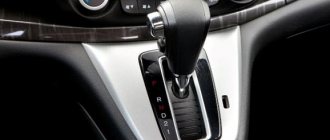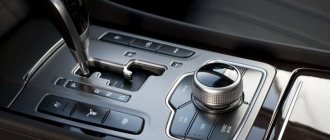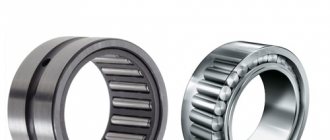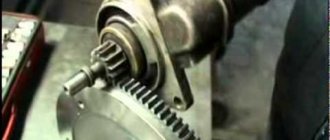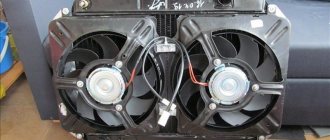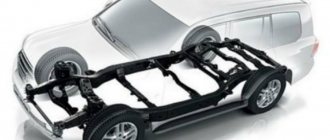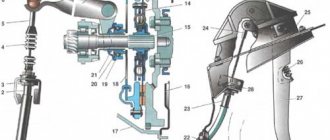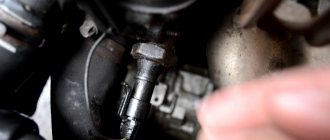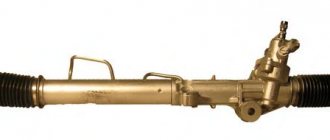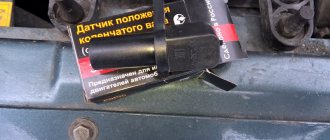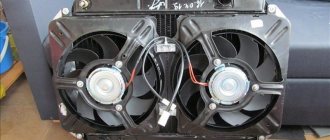Given the great popularity of hydromechanical automatic transmissions, manufacturers manufacture this type of transmission in such a way as to achieve maximum user convenience and versatility. At the same time, there is also the task of reducing fuel consumption.
As you know, the most common today is a simple four-speed automatic. As a rule, these gearboxes have several standard and understandable operating modes, which greatly simplifies operation.
However, on many automatic transmissions, in addition to the basic ones, you can also find additional modes. In this article we will talk about what overdrive is on an automatic transmission, how overdrive on an automatic transmission is turned on and off, why this mode is needed and when it is used.
Putty is the best option for repairs
Putty, as a material, is designed to effectively level out dents, some irregularities and cavities that are usually present on metal parts of a car body.
The use of putty is able to give the surface of the car the correct, original shape. The quality of such materials is constantly improving, as a result a large number of their varieties appear. Among the variety offered on the modern market, we can note such types of putty as:
- Fiberglass putty, which is designed to effectively seal fairly deep irregularities or cavities. This is a material that is more solid in consistency and does not allow the material to shrink significantly during the drying process;
- Polyester putty is used for effective smoothing and subsequent leveling before painting. The material lends itself well to processing, thereby providing a very smooth surface.
Materials for putty
The choice of a particular material should be based on the planned result, as well as on the skills and abilities of the master regarding the process of how to properly putty a car.
Overdrive mode on automatic transmission, how to use
Well, now we can move on to the practical part. However, before you do this, did you know what the flashing “O\D Off” sign means on the dashboard monitor?
If you didn’t know, then you shouldn’t press the “OverDrive” button on the machine. The fact is that when this inscription appears, the car owner, even if he really wants to, will not be able to turn on the “OverDrive” mode. Since the ECU of the box, in order to preserve the health of the machine, blocks it from human influence.
Do you know why the car’s electronic computer does this? Let's look at the instructions for using Overdrive on an automatic machine and under what conditions it should not be pressed.
- When accelerating on the highway, press the button on the selector. Overdrive helps you not to change gear after gear on an automatic transmission, but immediately sets it up.
- When moving in the city, press the button again. Although now many mechanics will say that I’m wrong, because in city mode there are a lot of stops, which means a drop in speed. Accordingly, constant switching on will only kill the machine. My answer is that these mechanics are wrong. Why?
Because the function can automatically turn off and does not require any action on the part of the driver to turn it off. Accordingly, to save fuel on long stretches of road without traffic jams or traffic lights (if you live in a metropolis or just a big city), turning on the mode will be useful.
Now you know how to use the “Overdrive” button on the automatic transmission. Let's look at when it shouldn't be turned on.
Reviews
Opinions about this innovation are raging very different, some are “for”, some are “against”. Let's try to figure this out.
| Positive | Negative |
| When I drive at high speed, the speed in the automatic transmission drops and the ride becomes more comfortable and confident. | In my opinion, this is simply the most unnecessary function in an automatic transmission. It can only be used during intense overclocking. |
| It was not invented to cut speeds of less than 90 km/h. Golden thing! | When the OD is turned off, the car will not travel above 135 km/h, because there is a limit. |
| When OD is turned off, gasoline consumes much more. So I try to use it more often when possible. | Generally an unnecessary thing, just constant jerks with these on and off switches. It's impossible to drive in the city, don't even try. |
| I always turn on the OD at around 80-90 km/h and during further acceleration. | In the morning in traffic jams - murder with this function. |
| I really like it, the driver has more than one year of experience. Helps in many situations. | Another thing not invented for our roads. |
| I drive it (OD), and the box just flies, and hasn’t broken yet. | There is a very high probability of getting into an accident, since the car slows down with the OA on, the car is much worse. |
| For those who love fast driving - this is just right! | I don’t know, maybe it will be useful on the highway, but in the city I don’t see the point. And he saves crumbs. |
If you do not want to use this mode, then we will tell you a secret that you will not lose anything. This mode is a service assistant and is completely optional. You and your car will not lose anything if you never turn it on during its entire lifespan. But for more experienced drivers, sometimes this element becomes an indispensable thing!
Why do you need overdrive on an automatic transmission?
If we consider the design of an automatic transmission with 4 gears (steps, speeds), in this case the 3rd gear is direct, that is, it has a gear ratio of 1, which is similar to the 4th gear of a manual transmission.
In this case, 4th gear in an automatic transmission is also called overdrive or O/D. By analogy with mechanics, the gear ratio of this gear is less than 1, that is, an overdrive gear, like 5th gear in a manual transmission.
As you know, manual overdrive is engaged at speeds of 80 or even 100 km/h. This transmission allows you to significantly save fuel when driving along the highway at high speed. In the case of an automatic transmission, where the driver cannot change gears independently, the O/D (overdrive) mode is separately turned on and off using a separate button.
The overdrive button can be located on the automatic transmission selector or placed separately. So, if automatic transmission overdrive is turned on, this means that the automatic transmission will switch to 4th (higher) gear at high speeds, and also if the driver lightly presses the gas pedal. After engaging 4th gear, the torque converter lockup is activated.
In practice, switching to 4th occurs already at a speed of about 45-50 km/h. It is quite obvious that 4th gear allows you to save fuel when driving on the highway, and also does not allow the engine to spin up to too high speeds.
However, many car owners have a question about what to do if the car is used within the city. In other words, do you need to turn on O\D in the city or turn off overdrive? Let's figure it out.
Overdrive mode on automatic transmission: how to use
So, if we consider all the arguments for and against, we can highlight the following:
- If the overdrive mode is turned on, 4th gear is engaged as early as possible, that is, fuel is saved,
- The engine runs less at high speeds, the life of the internal combustion engine is preserved,
- The operating instructions for various brands of cars specifically indicate that in difficult conditions the O/D mode must be turned off. At the same time, city driving with frequent stops and accelerations, overtaking and lane changes may well be considered difficult conditions.
- Also, in O/D mode, the automatic transmission switches to 4th gear more often, thereby increasing wear on the gearbox mechanisms. In parallel with overdrive turned on, the effect of engine braking is weakly expressed.
It becomes clear that when driving on the highway at a constant high speed, a higher gear (overdrive) must be engaged, since in this case the engine and gearbox operate in optimal mode, maximum fuel efficiency is achieved, etc.
If you turn off overdrive, the ability to switch to a gear higher than 3 is blocked. Also, switching to higher gears after the start occurs at increased engine speeds; when braking, the gearbox “holds” the gear engaged longer, that is, downshifting occurs only when a certain engine speed and speed are reached movements.
We also recommend reading the article about why the automatic transmission pushes, jerks or kicks when changing gears. From this article you will learn about the main reasons for the appearance of automatic transmission kicks, jolts or impacts in different operating modes.
By the way, you need to turn off O/D during prolonged overtaking at high speeds (more than 100 km/h). At the same time, briefly turning off the overdrive also allows you to do a kick-down, that is, when the driver sharply and strongly presses the gas pedal.
Also, overdrive should be turned off when towing a trailer, when driving on snow, ice, off-road, etc. Overdrive also needs to be turned off if, due to road conditions, you need to get the effect of engine braking.
In practice, if we talk about everyday use within the city, it is better to turn off overdrive on an automatic transmission. This can be done with a button located separately or on the gearshift lever. At the same time, O/D off lights up on the dashboard, which means 4th gear is disabled. If overdrive is turned on, nothing lights up on the dashboard.
https://youtube.com/watch?v=yJojxTWbBn8
Video “Overdrive Operation”
The video shows how the car gains speed using overdrive.
After studying our article and extracting a lot of useful information from it, we invite you to leave your comments on our page a little lower.
Owners of cars with automatic transmission will be interested to know what overdrive is and how to use it.
Despite the fact that any gearbox that changes the gear ratio in accordance with the vehicle speed and engine speed without direct driver intervention can be called automatic (automatic transmission), this name is assigned only to the hydromechanical planetary gearbox. Although in the last few decades there have been cars with automatic gear shifting of manual transmissions with electromechanical or electro-pneumatic actuators, they are not called “automatic”. They came up with the name “robot”. The variator is not a gearbox at all, since it does not have a set of steps with a fixed gear ratio, but smoothly changes it as needed, therefore it is classified as a continuously variable transmission.
Using the O/D automatic transmission mode in practice
To understand how to use the overdrive mode in the city, let's look at a specific example. The car can move uphill in traffic, constantly changing speed from 30 to 70 km/h.
If overdrive mode is turned on, the automatic transmission will shift to all gears (1,2,3,4). Also after accelerating to 40-50 km. The torque converter will be blocked if the driver does not press the gas pedal very hard.
Let's imagine that the car accelerates to 60 km/h, while 4th gear is engaged and the engine speed is low. If at a certain moment you need to accelerate, you should not expect a sharp response to pressing the gas pedal, since fourth gear is engaged, and there are not enough revolutions for intensive pickup in this gear.
All you have to do is press the gas harder, the kick-down will work, a sharp downshift will occur and acceleration will begin. Further, this situation is repeated many times. Naturally, in this case, comfort is significantly reduced, and the gearbox itself wears out faster and more intensely when constantly changing gears.
If you turn off overdrive, under load the car will move in a maximum of 3rd gear, and it reacts more responsively to pressing the gas pedal, the engine speed is higher, and without shifting down there is enough traction for acceleration.
However, you should not assume that disabling 4th gear will lead to an increase in fuel consumption. The fact is that the forced use of the kick-down mode if O/D is turned on ultimately leads to greater fuel consumption during city use.
It turns out that you need to be able to use the overdrive mode, turning it on and off depending on certain conditions. As mentioned above, it is better to turn off overdrive:
- if you practice active driving at low speeds,
- on long descents/ascents,
- if the pace of movement is constantly changing,
- for comfortable travel at speeds up to 50 km/h,
- when towing a trailer/carrying cargo in a car,
- during prolonged overtaking at medium speed,
By the way, regarding the last point, you need to remember that turning off overdrive will cause the engine speed to increase sharply, and the increase can be right up to the cutoff.
You also have to turn on/off the O/D mode with a separate button, and it is extremely unsafe to be distracted from the road at speed and, especially, while overtaking. For this reason, when overtaking on the track, it is optimal to use kick-down rather than overdrive.
The only exception is safe overtaking of relatively slow-moving vehicles. In this case, the overdrive is turned off in advance, only then does overtaking begin; if necessary, kick-down is also activated in parallel with the overdrive turned off.
Finally, we note that regardless of the type of transmission and the available modes of its operation, the main thing is to be able to correctly predict the situation, take into account road conditions, and the operating features of the automatic transmission on a particular car model. Only after making sure of complete safety can you overtake, change lanes and other maneuvers.
Page 38
“ODO” – “TRIP A” – “TRIP B”). To reset the daily mileage counter, in the daily mileage indication mode, press and hold the button for 2 seconds (for the “Standard” version, the current counter “TRIP A” or “TRIP B” is reset).
Switching to the clock setting mode
owls are carried out by pressing and holding for 2 seconds the button on the front panel of the instrument cluster when indicating the total mileage. Pressing the button once on the front panel of the instrument cluster increases the clock readings by one; holding the button for more than 1 second causes an accelerated increase in the clock readings by 4 units per second. If the button is not pressed for more than 5 seconds, the mode switches to the minutes correction mode (the change in the minute readings is similar to the clock correction). Further absence of pressing the button leads to exit from the correction mode to the clock readings mode.
Entering installation mode
hours is carried out by pressing and holding for 2 seconds the button on the front panel of the instrument cluster when indicating the total mileage. Time correction is made using the buttons
on the steering column switch. Exiting the correction mode is by pressing the button on the front panel of the instrument cluster or not pressing the buttons on the steering column switch for more than 5 seconds.
indicator
(see section “Liquid crystal indicator”).
20 – open indicator
doors.
Lights up red if the driver's door or
(in the optional version)
any of the passenger doors of the vehicle is open.
fuel.
Lights up yellow when refueling is necessary.
ki to avoid interruptions in engine operation.
Fuel reserve indicator
lights up when two or fewer segments of the fuel level indicator are illuminated. Turning on the light alarm is accompanied by an intermittent (2 repeated on/off for 0.5 seconds) sound signal from the buzzer.
Simultaneous flashing of the signal
lizer and “empty” contours of the fuel gauge segments indicate a malfunction in the fuel level sensor circuit.
22 – alarm indicator
to reduce tire pressure (optional) .
Lights up yellow when tire pressure decreases.
power steering (optional).
Lights up yellow when the ignition is turned on and goes out after the engine starts.
In all other cases,
The warning of the indicator indicates the occurrence of a malfunction, the elimination of which must be carried out only at a certified PSSS.
Source
When to turn off overdrive
It is recommended to disable this automatic transmission mode:
- Overtaking at high speed if this requires a lot of acceleration. In such a situation, it will be more effective to use the kick down mode.
- Driving off-road.
- Towing a heavy vehicle or trailer.
- Driving downhill when you need to slow down the engine.
- On a long climb.
- Moving at a speed of no more than 60 km/h.
- If the road situation requires a constant change in speed.
Overdrive in the city
Do I need to turn off overdrive in the city? There are two diametrically opposed opinions on this matter, which we will now present together with the arguments of both sides.
The first opinion is that in the city this mode must be turned off. This is explained by the fact that in the city, unlike on the highway, it is impossible to move for a long time at a constant speed, so the box will not be able to work in overdrive most of the time. This happens due to the large number of other traffic participants and traffic lights. And since the car cannot move for a long time in overdrive, its automatic transmission makes a large number of gear changes and torque converter locks. Therefore, firstly, fuel consumption increases, and secondly, wear of automatic transmission parts and components increases.
The second opinion, as you might guess, is that the mode that increases the automatic transmission ratio does not need to be turned off. The argument of drivers using overdrive mode in the city is as follows. In the city cycle, the automatic transmission makes more shifts than on the highway, regardless of whether overdrive is on or not. The situation is similar with fuel consumption, which, with the same driving style at the same time of year, in the city is higher than on the highway. Therefore, driving in overdrive will at least slightly reduce fuel consumption.
Operation of the box with stage IV turned on
If overdrive is not turned off, then when accelerating the car, the gearbox sequentially switches gears from I to IV.
Although this push is not a consequence of going into overdrive, its presence indirectly confirms that the box is switching to an upshift. During braking, the torque converter unlocks and shifts to lower gears.
How does the automatic transmission work when 4th gear is engaged?
When you press the button, the automatic transmission torque converter is blocked. The driver feels a slight jolt. You should not associate the push with going into Overdrive. The latter occurs due to blocking of the gas turbine engine.
Read
How to switch from an automatic transmission to a manual transmission yourself
If the car begins to brake, the “donut” is unlocked. After this, the downshift begins. The same thing happens when the speed decreases below 50 km/h.
What is the O/D button on an automatic transmission?
Overdrive is a special device that must be turned on when driving on highways and other roads where all conditions for high speed travel are created. At its core, overdrive is analogous to the fifth gear found in a manual transmission. The operating principle of this function is that when this mode is turned on, the box switches from 1st to 4th gear sequentially, and when turned off, 4th gear is blocked and the car moves in 3rd gear at maximum speed.
To understand why overdrive is needed, you need to look at the following example. Let's assume that a car is driving downhill in a dense stream of vehicles, where the speed range varies from 40 to 60 km/h. At the same time, O/D mode is enabled. When the speed decreases to 40 km/h, the transmission does not switch from 4th to 3rd, the speed drops, and the speed of the flow begins to increase. When starting to accelerate, it is very difficult for the car to quickly gain the required speed; moreover, the gearbox begins to work under too much load, which leads to its accelerated wear. To switch to 3rd, you need to sharply depress the gas pedal or reduce the speed by pressing the brake pedal, and this will make the car behave inappropriately and the shock loads on the automatic transmission will only increase.
At first glance, it will seem that in this case there is a big difference in fuel consumption. After all, if you drive at high speeds for too long, fuel consumption increases. There is a certain amount of truth in this. But do not forget that at low speeds when driving in top gear, fuel consumption also increases due to the fact that the engine efficiency drops sharply. Therefore, if there is a difference in fuel consumption, it is only the most insignificant. Naturally, when driving on the highway, overdrive should be turned on, since this will already be a real fuel economy.
Overdrive is activated using a special button on the automatic transmission mode switching handle. When O/D is turned off, a special indicator with the inscription “O/D off” lights up on the instrument panel, and when turned on, the inscription disappears, and when moving to 4th gear, a small jolt occurs, which means that the higher gear is engaged. The revolutions drop slightly. Many drivers mistakenly assume that this push means engaging 5th gear, although in fact, this is accompanied by a simple blocking of the hydraulic transformer.
Overdrive in the city
Should you use a higher gear when traveling within the city? The opinions of experts here are divided, and the arguments of both sides sound quite convincing and reasonable, so you will have to make a decision on your own.
Proponents of turning off this mode explain their position as follows: road conditions in modern cities are such that it is impossible to move at a uniform and relatively high speed for any length of time. This is hampered by dense traffic and the presence of adjustable traffic lights, which greatly influence the speed limit on certain sections of the road. This means that the box has to constantly switch, and when the mode is on, this will lead to frequent locking of the torque converter. And this means accelerated wear of this unit and an increase in fuel consumption that occurs out of the blue.
Adherents of using Overdrive believe that the last argument of their opponents is untenable. The point is that, regardless of whether the O/D button is turned on or off, the automatic transmission will still have to use frequent gear changes. And in this case, fuel consumption will certainly increase compared to driving on the highway, regardless of the time of year and the preferred driving style of the car owner. Therefore, even a short-term upshift will help save fuel.
The feasibility of using overdrive
Automatic transmission allows you to achieve improved machine performance. All thanks to the gears present, which ensure optimal operation of the power plant. With an automatic transmission, it is easier to move (start) on an incline. If you need to ensure an economical and comfortable ride on the highway, you should switch to a higher gear.
Advantages of overdrive mode on an automatic transmission:
- maximum fuel efficiency;
- comfortable movement over long distances.
However, frequent switching to 4th gear will lead to rapid wear of the gearbox mechanisms. When operating vehicles in the city, it is recommended to turn off O/D by pressing a special button located on the gearbox lever. Also, the mode should not be activated on long descents or ascents.
It is recommended to turn off O/D mode in the following cases:
- there is a rapid increase in speed on the highway before performing the maneuver;
- a trailer is being towed;
- off-road driving during icy conditions.
What it is?
O/D stands for Overdrive. It promotes automatic upshifting in the automatic transmission. In practice, the function is similar to the fifth speed mode. As a rule, it is used:
1. When driving on a highway
2. Roads with high speed traffic.
The basic principle of operation is gradual switching from 1 to 4 speed gears. If the engine is switched off, 4th gear is locked. The next time you move, third gear will be engaged at maximum speed.
Viking Overdrive - Berserker Reactor
| A tank that has used overdrive instantly reloads its gun and temporarily receives a significant increase in its effectiveness. |
Details
Each gun gets its own set of effects, including:
- endless cylinder/charges;
- increased rate of fire;
- increasing the range of destruction;
- increased damage/healing;
- increased impact force and reduced recoil;
- special shot effect.
Some guns with unique mechanics also receive special effects:
- Vulcan - instant spin-up of barrels, removal/prevention of overheating;
- Striker - disables multiple rocket launch mode (can only fire single shots);
- Magnum - disables charge power gain (each shot is fired with maximum power);
- Shaft - disables sniper mode (can only shoot offhand).
Interaction with other overdrives
The effect of the ability is interrupted (but does not stop completely) when the tank falls under the overdrive of an enemy Hunter.
Additional Information
- The ability is deactivated when the tank dies.
- Deactivating the ability for any reason causes a short pause during which the gun cannot fire.
- The effect of the ability affects projectiles that are in flight while overdrive is activated.
- The effect of the ability does not affect the rate of temperature change.
- The effects of installed devices may change while this ability is active.
Overdrive mode and fuel consumption
During our introduction to the operating principle of Overdrive, we stated that its use saves fuel. As practice shows, this effect is rather demonstrative in nature, indicating that less fuel is actually consumed.
That is, the driver, with proper use of the mode, which involves turning it on/off in a timely manner, can save a little, but you should not count on a significant reduction. So any myths about the influence of Overdrive on fuel consumption should be taken with a considerable amount of skepticism. There are savings, but they are insignificant.
MPRT or GtG response speed?
You'll also notice that some monitor manufacturers also include a 1ms MPRT (moving picture response time) specification. This is not the same as GtG response time. Instead, MPRT indicates that the monitor has motion blur reduction technology that uses backlight strobing to reduce perceived ghosting.
The problem occurs when a monitor manufacturer states that a display has a 1ms MPRT speed but does not show a GtG response time, misleading potential users that the monitor has a 1ms response rate when in fact the GtG response time may be 4-5 ms.
Motion blur reduction provides CRT-like motion clarity, but has its downsides: it reduces the monitor's maximum brightness when active and causes screen flickering—it also cannot work simultaneously with VRR (variable refresh rate) technologies such as FreeSync. and G-SYNC on most monitors.
Some gaming monitors can use VRR and MBR simultaneously, such as the ASUS VG279QM display with ASUS exclusive ELMB-Sync technology.
Manu
Alternative names: Hold, ETC Snow, Snow, current gear lock switch. When pressed, the currently selected gear is blocked from downshifting or upshifting, and a warning lamp in the instrument cluster lights up.
The button can be used in conjunction with the “D” mode and a manually selected gear – values 1, 2, 3, L on the mode scale.
In the first case, the car will start from 2nd gear. This will avoid slipping on ice and snow. In the second case, it makes it easier to climb/overtake and allows you to effectively use engine braking on steep descents, preventing overheating of the brake system elements and saving their life.
Description of the instrument panel Lada Granta and Kalina 2
The combination of devices of Lada Granta and Lada Kalina 2nd generation is designed to display driving characteristics, the current state of vehicle systems that ensure traffic safety, as well as the correct operation of the entire vehicle as a whole. Next, we will consider a description of the Lada Granta dashboard, as well as the meaning of instruments and alarms.
Description of the Lada Granta/Kalina 2 panel:
- tachometer , shows the speed of the engine crankshaft, the red scale zone indicates a dangerous operating mode for the engine;
- engine management system malfunction indicator (Check Engine) , turns on orange when the ignition is turned on and goes out after the engine starts, the lamp is lit after starting the engine or while driving indicates the failure of any element of the engine management system (does not mean that the engine should be stopped immediately, however, the cause should be eliminated as soon as possible), the error can be determined using the diagnostic connector;
- left turn signal indicator;
- emergency low oil pressure indicator , turns on in red when the ignition is turned on and goes out after starting the engine, the lamp is lit when the engine is running and a constant (for 5 s) buzzer signal indicates insufficient oil pressure in the system;
- ABS anti-lock braking system status indicator (optional) turns on orange when the ignition is turned on and after 2 seconds. after the engine starts, it goes out; in other cases, the lamp is lit, indicating a system malfunction that should be repaired at a specialized service station;
- immobilizer mode indicator lights up orange and displays the status of the immobilizer and the vehicle security mode;
- The coolant overheat indicator turns on in red when the ignition is turned on and after 5 seconds. after starting the engine it goes out, the sound signal indicates engine overheating (t>115C), the signal will be repeated until the temperature drops below 110C, when the indicator turns on, it is prohibited to operate the car, otherwise it will lead to serious engine damage;
- brake system emergency indicator , turns on red when the ignition is turned on and goes out after the engine is started, the lamp is lit and the buzzer signal (5 lights on) when the engine is running indicates a drop in the brake fluid level below the “MIN” mark in the master cylinder reservoir, operate the car with the light on indicator is prohibited;
- indicator for turning on the right turn signal (with a green filter in the form of an arrow);
- battery charging indicator , turns on in red when the ignition is turned on and goes out after the engine starts, the lamp is lit or glows half-lit while the engine is running indicates a lack of charging current due to a malfunction of the generator or voltage regulator, as well as low voltage (or breakage) of the belt generator drive, operating the vehicle with the indicator on is prohibited;
- speedometer , shows how fast the car is currently moving;
- indicator of the operating mode of the exchange rate stability system (ESC) (in a variant version), turns on yellow when the ignition is turned on and goes out after starting the engine, the lighting of the “ESC OFF” lamp indicates that the system is turned off, and lighting and flashing while driving indicates the activation of the exchange rate control system stability, in other cases the burning of the lamp indicates a system malfunction;
- signaling device prohibiting transition to higher gear “O/D OFF” (not used);
- headlight high beam indicator , indicates that the headlights are on high beam;
- signaling device for turning on the rear fog lights , indicates that the ZPTF is turned on;
- low beam headlight indicator , indicates that the headlights are low beam;
- indicator for turning on the front fog lights , indicates that the PTF is turned on;
- daily mileage counter reset button , by pressing the button, set the daily mileage counter in the liquid crystal display to 0 or select the daily or total mileage display modes;
- liquid crystal display of the on-board computer , displays information from the BC, see description below;
- door open indicator , lights up red if the door is open;
- reserve fuel indicator indicates the need to refuel the vehicle; do not allow the gasoline to run out completely, as this may damage the fuel pump;
- low tire pressure indicator , lights up when tire pressure drops;
- the electric power steering status indicator (connected in a variant), turns on in orange when the ignition is turned on and goes out after the engine is started; the lamp is lit while the engine is running indicates a malfunction of the power steering, which must be eliminated as soon as possible;
- driver's seat belt warning light , lights up when the ignition is turned on if the seat belt is not fastened;
- power unit fault indicator (not used);
- Airbag status indicator turns on in orange when the ignition is turned on and goes out after the engine starts; in other cases, the lamp is lit indicating a system malfunction; you must contact service as soon as possible, because In addition to failure in an emergency, the airbag may unexpectedly inflate.
How to use overdrive on an automatic transmission?
To date, there is no clear explanation of how to use this function. This is due to the large differences in driving situations and engine power in different cars. Drivers enable and disable this feature based on years of experience, but what should newbies do?
This question can be answered by experts who give the following recommendations on this matter. Here are the following cases when you need to disable O/D:
- When driving on long descents or ascents
. It’s completely understandable why you would do this on climbs, but why turn off overdrive on the descent? When you engage a higher gear, the car coasts better, which means that braking efficiency decreases, which has a great impact on traffic safety. That is why, on descents, overdrive must be turned off. - When driving in a dense flow of vehicles
, where the speed of movement periodically changes. - When overtaking at a speed not exceeding 90 km/h
. Although the opinion with overtaking is controversial. On the one hand, increasing the speed helps to quickly complete the maneuver, but on the other hand, it is no longer safe to remove your hand from the steering wheel to press the button, although overdrive can be turned off by sharply pressing the gas pedal all the way. In addition, if you do not know your car, you can bring the engine speed to the red zone when reducing the gear, which will accelerate its wear. Everything will depend on your experience driving this car.
The question of the application of this function in the city is also controversial. It all depends on the engine response and specific driving conditions. Therefore, there is still no clear explanation on this matter.
Where should overdrive be used? When driving on the highway, as well as in any places where a sufficiently high speed is allowed.
Manufacturers manufacture this type of transmission in such a way as to achieve maximum user convenience and versatility. At the same time, there is also the task of reducing fuel consumption.
As you know, the most common today is a simple four-speed automatic. As a rule, these gearboxes have several standard and understandable operating modes, which greatly simplifies operation.
However, on many automatic transmissions, in addition to the basic ones, you can also find additional modes. In this article we will talk about what overdrive is on an automatic transmission, how overdrive on an automatic transmission is turned on and off, why this mode is needed and when it is used.
Read in this article
Features of automatic transmission operation (4 speed)
An automatic transmission allows the gear ratio to change with the speed of the vehicle without driver intervention. The range selector has an alphabetic and numerical designation. This type of transmission has a long service life. In addition, it allows you to effectively reduce speed and hold cars on an uphill or downhill slope.
When O/D is engaged, the automatic transmission shifts sequentially from 1st to 4th gear. In Overdrive mode, 4th gear is locked and the car moves only in 3rd gear. At the same time, there is a sharp acceleration. Overdrive can be considered an analogue of the 5th gear of a standard manual transmission. When switching off, the word O/D off lights up on the instrument panel.
You can downshift if the Kick Down mode of the automatic transmission is activated. It is activated when the accelerator pedal is fully depressed.
The transition to 4th occurs while driving, when the speed begins to exceed 45 km/h. With overdrive engaged, when accelerating, the transmission shifts sequentially from first to fourth gear, after which the torque converter lock-up is activated. As a rule, it is impossible to move around the city at a constant speed. This is due to the fact that you have to make frequent stops at traffic lights.
When to turn off Overdrive
Since the driver has the ability to turn this mode on/off at his own discretion using the O/D on/off button, usually located on the selector lever, he needs to know how Overdrive works, when this mode will be useful, and when its use is useless.
Note that you always need to turn on Overdrive only with a button, but turning it off can also occur in automatic mode if you sharply press the accelerator pedal all the way. This action will activate the Kick Down mode, forcing the automatic transmission to shift to a lower gear. In this mode, Overdrive will be blocked.
Many drivers have difficulty determining whether Overdrive is currently on or not in use, since there is no point in focusing on the selector lever. But you can easily find out about this from the display on the instrument panel. Thus, the inscription “O/D off” indicates that the transmission does not intend to use overdrive, regardless of the vehicle’s speed limit.
Pressing the button again will cancel the mode ban, while the display will light up the inscription “O/D on”, and the automatic transmission will engage 4th gear as soon as suitable conditions are created for this (when reaching a speed of 50-55 km/h, the driver slightly will slow down).
Let's look at how to properly use the Overdrive button. Disabling this mode is recommended in the following situations:
- if you are driving at high speed and need to overtake with sudden acceleration. In this case, it is advisable to use the Kick Down mode;
- when driving a vehicle off-road;
- if the car has a trailer or is towing another vehicle;
- if the car goes downhill and engine braking is required;
- during a long climb;
- if road conditions require driving at a speed of less than 55-60 km/h;
- in cases where the driving mode requires frequent or constant changes in speed.
Why doesn't the Overdrive button work?
The Overdrive button on the automatic transmission may fail. For example, when the mode is on, the screen on the dashboard does not display information that Overdrive is on. But if the button is turned off, the light comes on.
If pressing the button does not extinguish the “O\D off” signal, then the key is faulty. Reasons for failure:
- physical wear of the button;
- the life resource has run out;
- poor contact;
- broken wires;
- gearbox is faulty.
In the latter case, you need to contact a service center for diagnostics as soon as possible. You won't be able to check it yourself. You will need a scanner and special software. Therefore, if it is impossible to turn on the key, contact experienced mechanics at the service station immediately.
Main modes:
"P"
This mode is used when parking. You can turn it on only after the car has come to a complete stop on a level surface. The transition to “P” mode is carried out before the brake pedal is released. After switching, the motor will be disconnected from the transmission. An additional gear is used for locking.
Important: if you use “P” while driving, you can break the locking gear, which can lead to expensive engine repairs. Also, you cannot use the described mode without the car’s hand brake, when parking on a slope exceeding 15 degrees. Also, you cannot use the described mode without the car’s hand brake, when parking on a slope exceeding 15 degrees.
Also, you cannot use the described mode without the car’s hand brake, when parking on a slope exceeding 15 degrees.
"R"
Reverse driving mode. Reverse can only be activated after the vehicle has come to a complete stop. Before starting to move backwards, you should wait approximately 1.5 seconds. Without pressing the lock button on the automatic transmission handle, you can only switch from this mode to neutral.
"N"
Neutral gear. In it, the engine idles (does not transmit torque to the wheels). Typically, neutral is used for short stops. It is highly not recommended to engage neutral gear until the car has stopped. Neutral is also used when towing a car. In this case, towing should take place at a speed no higher than 45 km/h (and for a short time).
You can return to the same mode without removing the button from the “Drive” mode when you come to a complete stop.
"D", "D1", "D2", "D3"
The main operating mode of the automatic transmission is indicated by the letter “D”. Driving in 4 gears. In this mode, depending on the current pressure of the gas pedal, the electronics itself will downshift or upshift.
Modes designated simply by numbers (1, 2, 3) or the letter “D” with one of the numbers mean lower gears. Accordingly, in 3 gear the box will not shift above third gear. In 2nd gear the automatic transmission will not shift above 2nd gear.
Mode “D1” or “1” or “L” is the use of only first gear. It is used in cases where the vehicle speed cannot exceed 25 km/h. Under no circumstances should this mode be activated while driving at high speed! Otherwise, loss of control and skidding may occur. “Unity” is also used in situations where you need to make full use of the car’s engine braking capabilities.
Why do you need an upgrade step?
Overdrive is needed for more comfortable and economical travel over long distances. It should be enabled under the following conditions:
- Driving on the motorway.
- Continuous movement at constant speed.
- Traveling at high speeds.
Other operating modes of the machine
Using the selector handle you can select the following operating modes:
- P (parking) – Parking. In this mode, the intermediate shaft of the box is mechanically blocked, which leads to braking of the drive wheels. Starting the engine is usually possible only in this mode.
- R (rear) – Reverse.
- N (neutral) – Neutral. In this mode, the vehicle can be towed over short distances.
- D (drive) – Moving forward. Usually all stages of the transmission operate.
- 2 – range of low gears (1 and 2 or only 2) for driving on snow or mud.
- S (snow) - helps to move in modes with a reduced coefficient of adhesion to the road surface.
- L (low) or 1 – second low range (1 step only).
Gear ratio
The gear ratio is calculated as the ratio of the number of teeth on the driven gear to the number of teeth on the drive gear. It shows how many times the moment of force on the driven shaft is greater than on the driving shaft and is inversely proportional to the ratio of the angular velocities of the driven and driving shafts. In other words, a gear ratio below unity, which has overdrive, indicates that the moment of force on the secondary shaft of the box is less than on the primary shaft. And the rotation speed of the secondary shaft, on the contrary, is greater than the primary one.

